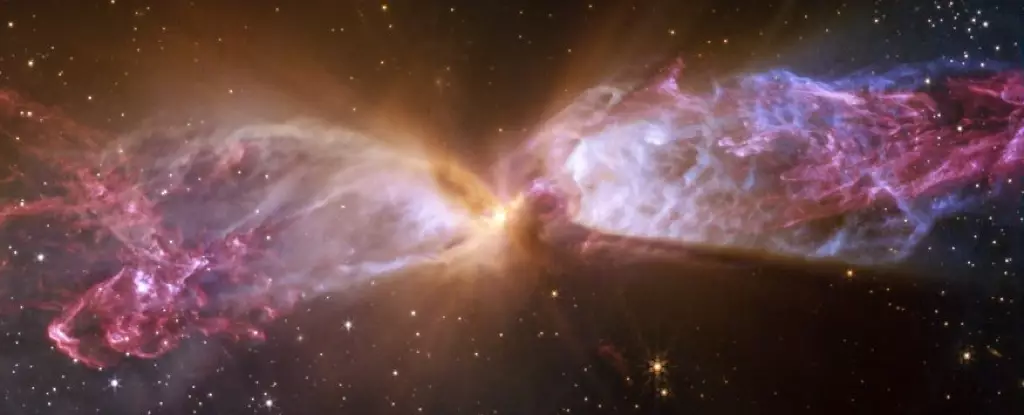In the vastness of the universe, young stars are reminiscent of energetic children—uncontainable and wild. Their formative years are characterized by intense activity, as they embody the tempestuous nature of stellar evolution. A recent image captured by the James Webb Space Telescope (JWST) reveals this dynamic process taking place about 650 light-years away in a dense region known as Lynds 483 (L483). Here, the energetic jets emitted by two nascent stars are sculpting their environment into an intricate hourglass shape, filled with cloud-like formations of gas and dust that mirror the chaos of youth.
Young stars develop by accreting surrounding gas and dust, gradually accumulating mass. While many stars cap out at around 20 solar masses, a select few can reach up to 200 solar masses during their formation phase. Yet, the journey of stellar growth isn’t a straightforward absorption of matter; it is an intricate balance between accretion and ejection. As these young protostars consume their surroundings, they also expel energy and material in powerful jets—a phenomenon that adds to the complexity of their early life stages.
A Peek into the Process of Star Formation
The striking images from the JWST showcase the enigmatic L483, a region where new stars are in the throes of formation. Deep within this enveloping cloud of gas and dust lie two fledgling protostars whose presence profoundly influences their environment. Although the JWST’s images show these stars as mere dots against a backdrop of vibrant colors and patterns, the complex interactions they foster are profound. Their gravitational pull causes nearby matter to form a swirling accretion disk, yet not all of this matter becomes part of the stars. In an elaborate dance of cosmic forces, some of it is channeled towards the poles of the stars, yielding the jets that characterize their youthful exuberance.
The jets emitted by these protostars are neither constant nor uniform. They result from intermittent accretion processes and have been releasing matter for tens of thousands of years. As newer jets collide with older material, the resulting interactions create a stunning visual spectacle of lumps and swirls. These formations are chemically-rich clouds—a nursery of organic molecules essential for the building blocks of life as we know it.
Scientific Breakthroughs Through High-Resolution Observation
The JWST is heralded as a revolutionary instrument in the field of astronomy, as it possesses the capability to probe deeper into infrared wavelengths than its predecessors. In regions dense with gas and dust, such as L483, visible light offers little insight. The telescope’s design fulfills the need to explore these obscured areas, revealing previously hidden details. The dual nature of L483—both symmetrical and asymmetrical—poses challenging questions for astronomers seeking to piece together the life story of the stars within it.
Recent findings indicate that complex organic molecules (COMs), such as methanol and carbon dioxide, are synthesized in hot regions surrounding the young stars. This phenomenon is particularly intriguing because it suggests that the chemistry of potential life-giving compounds could be taking root even before the stars become fully-fledged entities in their stellar lifecycle.
Unraveling the Mysteries of the Universe
The intricate patterns of thin filaments observed in the latest JWST images provide scientific stimuli for extensive inquiry. Questions abound: How did these structures form? What roles do they play in the star formation process? The JWST’s observations serve not only to affirm existing astrophysical theories but also to stimulate new lines of research, extending humanity’s understanding of celestial phenomena.
As astronomers delve into the mysteries of L483, they aim to quantify the mass ejected by the protostars, better understand the chemical environment, and explore how these phenomena might lead to the formation of planets in the distant future. The gas and dust swirling in their vicinity could one day give rise to new worlds, but conceivably, that won’t occur for millions of years. When the stars reach the main sequence stage and begin hydrogen fusion, the dramatic hourglass shapes and furious jets will fade away, transforming their surroundings forever.
The Future of Stellar Observation
When the inevitable transition occurs and these stars become more stable in their fusing phase, they will join the ranks of the thousands of other stars in our galaxy, each with its own unique history. The JWST, with its brilliant capabilities, allows us glimpses into these ancient celestial sagas, helping us understand how stars influence their domains. As we continue to learn from L483 and regions like it, it raises the tantalizing question: what will the next generation of telescopes reveal about the cosmos? It’s a future where our current technological marvels may seem dim in comparison, yet it opens exciting avenues for discovery and comprehension of the universe at large.

